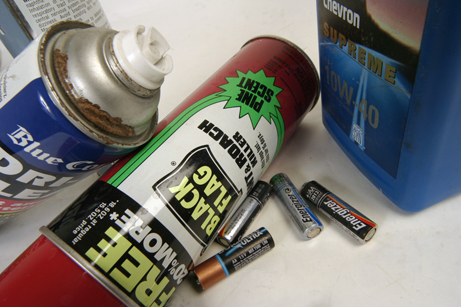
Residents have a place to take household hazards
There is a place for old paint cans that are collecting dust in
the garage, for antifreeze and herbicides past their expiration
date, for empty old aerosol cans and nail polish remover bottles.
For the few dozen household items that are considered hazardous
materials, the San Benito County Integrated Waste Management sets
up shop once a month to collect the items at the John Smith Road
Landfill.
Residents have a place to take household hazards
There is a place for old paint cans that are collecting dust in the garage, for antifreeze and herbicides past their expiration date, for empty old aerosol cans and nail polish remover bottles. For the few dozen household items that are considered hazardous materials, the San Benito County Integrated Waste Management sets up shop once a month to collect the items at the John Smith Road Landfill.
Like many recycling programs, the household hazardous waste program started after a state law passed in the ’90s. The law is constantly changing, but the items now collected have been found to cause serious health risks for humans and for the environment.
“The key thing is that [scientists] develop more and more testing processes that can get down to parts per billion or per trillion,” said Mandy Rose, director of SBC’s integrated waste management department. “They get that data and make rules that correspond to the health risks.”
Dealing with hazardous waste takes the biggest chunk out of the integrated waste budget.
“All of these materials go to a special facility so it is the most expensive program we run,” Rose said.
Many of the materials such as oil, latex and some paint materials are recycled into other products such as fuel. Other items can be burned safely in controlled situations by trained specialists. The most expensive items are those that need to be buried in a class-one facility. These facilities store the items underground in a way that prevents them from seeping into the environment.
The county collects residential hazardous materials once a month, though they get the biggest turn out early in the year.
“Our average count is 75 to 100 people and for a community our size that is low,” Rose said. “We get some people that come back every month.”
When they send out the new collection dates with the garbage haulers at the beginning of the year more residents turnout at the next collection date but after that the numbers drop off again.
“The frustration is that we send these things out and we still get people phoning up and saying they didn’t know about it,” Rose said.
The most common items collected are paint and oil. Residents can drop off up to 15 gallons or 125 pounds of waste at a time. It is against federal regulations to transport more than that.
“The department of transportation prohibits it unless you have a placard telling what you are carrying,” Rose said.
In addition to the hazardous waste, the county also manages electronic waste programs through the John Smith Road Landfill. Televisions, computer monitors and hard drives can be dropped off for free at the landfill during operating hours. For those items, consumers pay a recycling surcharge at the time of purchase. With other items such as DVD players and VCRs, the charge for dropping them at the landfill is the same as other trash.
“Sometimes it’s a matter of quantity with TVs and computers” Rose said. “One or two won’t create a hazard, but thousands will.”
Items are accepted the third Saturday of the month at 2650 John Smith Rd. from 9 a.m. to noon. The next collection will be Dec. 16.
Melissa Flores can be reached at mf*****@pi**********.com.
******************
Of course, one of the best ways to get rid of hazardous waste is to use products that contain less poison. The Integrated Waste Management department has a variety of alternatives for some common household hazards.
batteries can be replaced by rechargeable batteries, solar powered or AC adapters
chemical fertilizer can be replaced by compost, wood ashes, peat moss, fish meal or manure
chlorine bleach can be replaced by vinegar, baking soda and borax
floor and furniture polish can be replacedy by olive oil and lemon juice in a 2:1 ratio
For more information, call 636-4110 or visit www.san-benito.ca.us/departments/iwm/household_haz_waste.htm.








